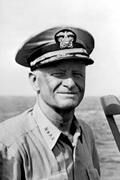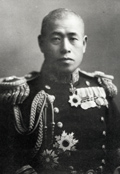
 Admiral Chester W. Nimitz |
All great battles develop their own unique mythos. That is to say, they become wrapped in a set of popular beliefs — "the common wisdom" — that interprets the battle and its meanings. In many cases, this mythology centers on a pivotal event — some noteworthy occurrence that captures the imagination, thereby crystallizing what the battle was all about. This has certainly been true of Midway, whose defining moment will always be the devastating and seemingly last-minute attack of American dive-bombers against the Japanese carrier task force at 1020 on the morning of 4 June. The image of American Dauntlesses hurtling down from the heavens to drop their bombs on helpless Japanese carriers, their decks packed with aircraft just moments away from taking off, has been emblazoned on the American consciousness since the day the battle was fought.
Yet, this precise version of the events surrounding the decisive attack — a rendition that would be accepted in any contemporary history book — is but one, and perhaps not the greatest, of the misconceptions surrounding Midway. In fact, the 1020 attack did not happen in this way, in that it did not catch the Japanese in any way ready to launch their own attack. Other myths of the battle include:
All of these are fallacious. All are either untrue, or at least require careful clarification. Some of these ideas have been implanted in the Western accounts as a result of misunderstandings of the records of the battle. Some have resulted from a faulty understanding of the basic mechanics of how the battle was fought. Some are misrepresentations of the truth that were deliberately introduced by participants in the battle. And each has caused lasting distortions in Western perceptions of the reasons for victory and defeat. Correcting these distortions is the overriding goal of Shattered Sword. Some of these corrections and clarifications will undoubtedly be controversial. But all of them are backed by solid research and documentation, which is why we've garnered high praise from some of the foremost historians in the field. We hope after you've read Shattered Sword that you'll agree.
|
 Admiral Yamamoto Isoroku |
|
Home - The Battle - Myths - Reviews - The Authors - News - Contact - Purchase |